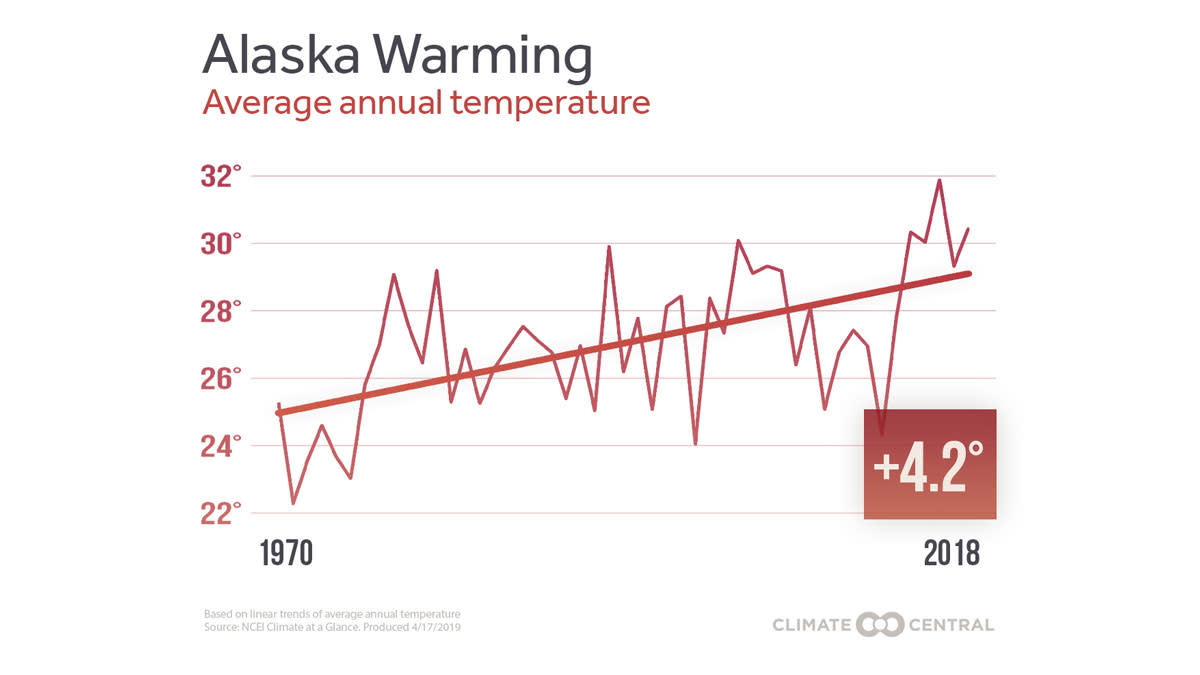SUMMARY
Americans marked the first Earth Day 49 years ago this month — and since then, human emissions have made America hotter
Climate Central assessed temperature data at states and cities across the U.S., showing a clear warming trend
Details and rankings below — and read our related report, here
As humans have burned fossil fuels and emitted greenhouse gases, the Earth’s atmosphere has gotten warmer. That’s the basic dynamic of human-driven climate change. Warming matters today because it is at the root of dangers that are already affecting Americans, from droughts, sea-level rise, and wildfires, to heatwaves, heavy downpours, and public health problems.
But just how much warming have we seen so far? To find out, Climate Central assessed temperature trends at 242 cities and 49 states across the U.S. Read on for details, rankings, and data downloads for your city and state.
HEATING UP
Since the late nineteenth century, the Earth has heated up by a little more than 1.8°F (1°C). The United States has warmed by a similar amount (1.3°F to 1.9°F since 1895), and most of that warming has occurred in years after the first Earth Day in 1970 — 49 years ago this month. That warming has not been equally distributed across the United States.
Alaska is America’s fastest-warming state. There, average temperatures have increased by 4.2°F since 1970. The Southwest is another hotspot. New Mexico, Arizona, and Utah have all heated up by at least 3°F since 1970. And the Southwestern cities of Las Vegas, El Paso, Tucson, and Phoenix have warmed more than any others in the country. Each has gotten at least 4.3°F hotter since the first Earth Day.
These examples may seem extreme, but they are not exceptions. Since 1970, temperatures have risen at nearly 98 percent of the cities assessed by Climate Central, and temperatures rose at least 1.8°F in all U.S. states measured. Ten cities have warmed by at least 4°F. 59 cities—including the major cities of Philadelphia, Atlanta, and Houston — have gotten at least 3°F warmer.
“Atmospheric gases such as CO2 let sunshine in but trap outgoing radiation," said Dr. Scott Denning, a professor of atmospheric science at Colorado State University. "This causes warming everywhere, but especially on land in the Northern Hemisphere, because the heat capacity of the oceans makes them much slower to warm. Americans are already seeing substantial impacts on crops, vegetation, seasons, and snow.”
YOUR LOCAL DATA + MORE BACKGROUND
For data on warming trends for your city and state, click here.
For Climate Central’s short report on U.S. warming, click here.
For graphics showing warming trends by city, visit Climate Central’s media library.
HOT AND BOTHERED
Warming drives most of the hazards associated with climate change. Higher average temperatures can boost evaporation, for instance, making dry areas drier and making wet places wetter, and in turn encouraging damaging droughts and heavy downpours. Warming boosts sea levels, increasing the reach of storm surges, and it makes some hurricanes, such as 2017’s Hurricane Harvey, more destructive. It has added to the stress on water supplies and improved the conditions for the spread of disease-carrying pests. In communities on the leading edge of America’s climate impacts — such as the one on Isle de Jean Charles, a low-lying settlement on the Gulf Coast — the effects of warming are helping to endanger long-cherished ways of life. And warming is damaging public health, not just through dangerous heat waves but also by exacerbating ground-level ozone pollution, which is responsible for thousands of deaths in the United States each year, and in which warm temperatures play an important role. Without deep cuts to warming emissions, these dangers will worsen.
FOR MORE INFORMATION
Climate Central’s short report on recent warming in the United States, American Warming: How the U.S. Has Heated Up Since the First Earth Day
The Fourth National Climate Assessment, for climate impacts by region
Climate Central’s Extreme Weather Toolkits, which unpack the connections between weather and climate change
A map showing what summer temperatures will feel like in U.S. cities later this century, from Climate Central
